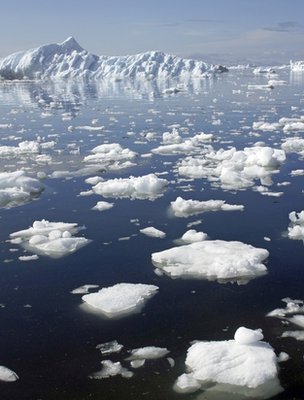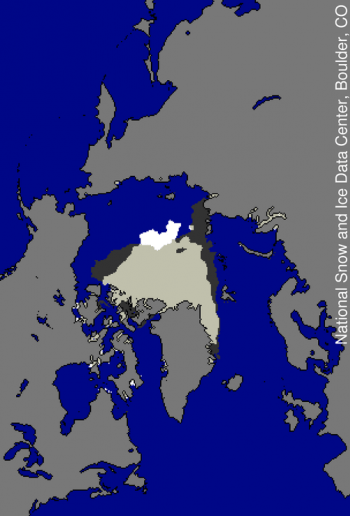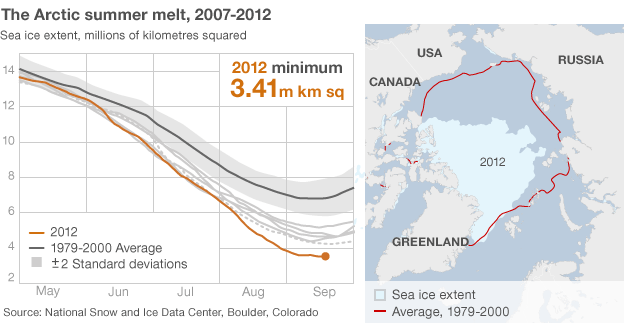 Well … we are at an all-time low now. Arctic sea ice appeares to have reached its minimum extent for the year, and that extent is 3.41 million square kilometers (1.32 million square miles). It is the lowest seasonal minimum extent in the satellite record … ever.
Well … we are at an all-time low now. Arctic sea ice appeares to have reached its minimum extent for the year, and that extent is 3.41 million square kilometers (1.32 million square miles). It is the lowest seasonal minimum extent in the satellite record … ever.
Here are a few scary facts for you …
- This year’s minimum is 18% below 2007 and 49% below the 1979 to 2000 average.
- The six lowest seasonal minimum ice extents in the satellite record have all occurred in the last six years (2007 to 2012).
- In contrast to 2007, when climatic conditions (winds, clouds, air temperatures) favored summer ice loss, this year’s conditions were not as extreme. Summer temperatures across the Arctic were warmer than average, but cooler than in 2007.
The primary reason for the large loss of ice this summer is that the ice cover has continued to thin and become more dominated by seasonal ice. This thinner ice was more prone to be broken up and melted by weather events, and we had such an event. There was a very strong storm centered over the central Arctic Ocean in early August.
 There is nothing better than a picture to show you what has been going on. OK, so take a look on the picture on the left.
There is nothing better than a picture to show you what has been going on. OK, so take a look on the picture on the left.
There you can see the different distribution of ice extent at the time of the September 2012 minimum, compared to the September 2007 minimum.
- Dark gray indicates where ice extent was present only in 2007;
- White indicates where ice extent was present only in 2012;
- Light gray shows where ice extent was present in both 2007 and 2012.
But that is all very far away, nobody actually lives up there, so does any of this really matter? In fact it makes trade a lot easier, with no ice in the summer, shipping routes open up, and we also get access so that we can drill for oil.
Oh but wait … oh come on, you knew there was a “but” to all this … right?
A 2011 study published in Nature journal, used proxies such as ice cores and lake sediments to reconstruct sea ice extent in the Arctic over the last 1,450 years. The results suggest the duration and magnitude of the current decline in sea ice may be unprecedented over this period. In other words, the Arctic may have entered a new climate era.
Dr Julienne Stroeve, a research scientist with the NSIDC, advises …
“The loss of summer sea ice has led to unusual warming of the Arctic atmosphere, that in turn impacts weather patterns in the Northern Hemisphere, that can result in persistent extreme weather such as droughts, heat waves and flooding.”
Dr Poul Christoffersen, from the University of Cambridge, told the BBC …
“We know very little about the consequences of drastic sea ice reductions.
“Most model predictions have sea ice declining less fast. But the fact is that less sea ice means more heat going into the upper ocean and the lower atmosphere. There could be some large scale effects from this, such as shifting wind patterns, surface ocean currents and potentially the jet stream.
“The wet northern European summer of 2012 could very well have been influenced by the record low extent of sea ice in the Arctic.”
Here is some more data for you to mull over …
Are you are tempted to think that it is time to start getting serious about this? Well it is not, we passed that point several decades ago.
